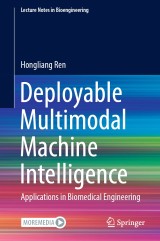Details

Deployable Multimodal Machine Intelligence
Applications in Biomedical EngineeringLecture Notes in Bioengineering
|
90,94 € |
|
| Verlag: | Springer |
| Format: | |
| Veröffentl.: | 04.02.2023 |
| ISBN/EAN: | 9789811959325 |
| Sprache: | englisch |
Dieses eBook enthält ein Wasserzeichen.
Beschreibungen
This book highlights the principles, design and characterization of mechanically compliant soft and foldable robots. Traditional rigid robots with bulky footprints and complicated components prolong the design iteration and optimization for keyhole and minimally invasive transluminal applications. Therefore, there is an interest in developing soft and foldable robots with remote actuation, multimodal sensing and machine intelligence. This book discusses the use of foldable and cuttable structures to design biomimetic deployable soft robots, that can exhibit a fair number of motions with consistency and repeatability. It presents the overall design principles, methodology, instrumentation, metamorphic sensing, multi-modal perception, and machine intelligence for creating untethered foldable active structures. These robotic structures can generate a variety of motions such as wave induction, compression, inchworm, peristalsis, flipping, tumbling, walking, swimming, flexion/extension etc.Remote actuation can control motions along regular and irregular surfaces from proximal sides. For self-deployable medical robots, motion diversity and shape reconfiguration are crucial factors. Deployable robots, with the use of malleable and resilient smart actuators, hold this crucial advantage over their conventional rigid robot counterparts. Such flexible structures capable of being compressed and expanded with intelligence perceptions hold enormous potential in biomedical applications.<p></p><p></p>
reviews orimimetic deployable mechanisms with potential functionalities in biomedical robotics.- Deployable and interchangeable telescoping tubes actuated with multiple tendons.- Deployable and foldable parallelogram mechanism for generating remote center of motion.- Origami Bending and Bistability for Transoral procedures.- Force-sensitive origami trihexaflexagon gripper actuated by foldable pneumatic bellows.- Untethered Inflatable Origami.- Wormigami and Tippysaurus origami structures.- Multi-leg insect-size soft foldable robots.- Magnetically Actuated Luminal Origami (MALO).- Compressable and steerable Slinky motions.- Electromagnetically actuated origami structures for untethered optical steering.- Untethered soft ferromagnetic quad-jaws cootie catcher with selectively coupled degrees of freedom.- Wearable Origami Rendering Mechanism (WORM) for aspiring haptic illusions.- Wearable Compression-aware Force Rendering (CAFR) with deployable compression generating and sensing. These multi-DOF deployable robots integrated tactile interface sensing and multimodal actuation.- Kinesthesia sensorization of foldable tubular designs using soft sensors.- Flat Foldable Kirigami for Chipless Wireless Sensing.- Deployable kirigami for intra-abdominal monitoring.- Stretchable Strain Sensors by Kirigami Deployable on Balloons with Temporary Tattoo Paper.- Multi-DOF proprioceptive origami structures with fiducial markers and computer vision-based optical tracking.- Multimodal robotic deployable mechanisms with intelligent perception capabilities.<p></p><p></p><p></p><p></p><p></p><p></p><p></p><p></p>
<p>Hongliang Ren received his Ph.D. in Electronic Engineering (Specialized in Biomedical Engineering) from The Chinese University of Hong Kong (CUHK) in 2008. He served as an Associate Editor for IEEE Transactions on Automation Science & Engineering (T-ASE), Medical & Biological Engineering & Computing (MBEC) among the other 6 journals. He has navigated his academic journey through the Chinese University of Hong Kong, Johns Hopkins University, Children’s Hospital Boston, Harvard Medical School, Children’s National Medical Center, United States, and the National University of Singapore. He is currently Associate Professor, Department of Electronic Engineering at Chinese University of Hong Kong, and Adjunct Associate Professor, Department of Biomedical Engineering at the National University of Singapore. His areas of interest include biorobotics, intelligent control, medical mechatronics, soft continuum robots, soft sensors, and multisensory learning in medical robotics. He is therecipient of the NUS Young Investigator Award and Engineering Young Researcher Award, IAMBE Early Career Award 2018, Interstellar Early Career Investigator Award 2018, and ICBHI Young Investigator Award 2019.</p>
He has won numerous international awards, including EMedic Global Gold Medal(2017) and Silver Medal(2021), Best Conference Paper Awards in IEEE ROBIO 2019, IEEE RCAR 2016, IEEE CCECE 2015, IEEE Cyber 2014, and IEEE ROBIO 2013 among 30+ others research awards. He delivered 70+ invited talks on intelligent surgical robotics/sensing at flagship conferences in medical robotics (10+ Plenary/keynotes), 40+ patents, and 3 books (Springer, Elsevier). The H-index (Google Scholar) of his publication profile is 50, with more than 9060+ citations as of July 2022.<p></p><br><p></p>
He has won numerous international awards, including EMedic Global Gold Medal(2017) and Silver Medal(2021), Best Conference Paper Awards in IEEE ROBIO 2019, IEEE RCAR 2016, IEEE CCECE 2015, IEEE Cyber 2014, and IEEE ROBIO 2013 among 30+ others research awards. He delivered 70+ invited talks on intelligent surgical robotics/sensing at flagship conferences in medical robotics (10+ Plenary/keynotes), 40+ patents, and 3 books (Springer, Elsevier). The H-index (Google Scholar) of his publication profile is 50, with more than 9060+ citations as of July 2022.<p></p><br><p></p>
This book highlights the principles, design and characterization of mechanically compliant soft and foldable robots. Traditional rigid robots with bulky footprints and complicated components prolong the design iteration and optimization for keyhole and minimally invasive transluminal applications. Therefore, there is an interest in developing soft and foldable robots with remote actuation, multimodal sensing and machine intelligence. This book discusses the use of foldable and cuttable structures to design biomimetic deployable soft robots, that can exhibit a fair number of motions with consistency and repeatability. It presents the overall design principles, methodology, instrumentation, metamorphic sensing, multi-modal perception, and machine intelligence for creating untethered foldable active structures. These robotic structures can generate a variety of motions such as wave induction, compression, inchworm, peristalsis, flipping, tumbling, walking, swimming, flexion/extension etc.Remote actuation can control motions along regular and irregular surfaces from proximal sides. For self-deployable medical robots, motion diversity and shape reconfiguration are crucial factors. Deployable robots, with the use of malleable and resilient smart actuators, hold this crucial advantage over their conventional rigid robot counterparts. Such flexible structures capable of being compressed and expanded with intelligence perceptions hold enormous potential in biomedical applications.<p></p><br>
Highlights the use of flexible structures/robots being compressed and expanded with machine intelligence Discusses the overall design principles and methodology of the untethered foldable active structures Presents how remote actuation can control motions along regular and irregular surfaces from proximal sides

















